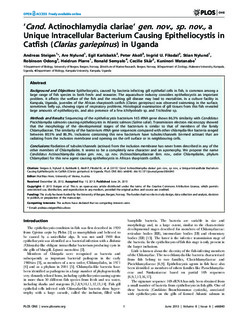| dc.contributor.author | Steigen, Andreas | |
| dc.contributor.author | Nylund, Are | |
| dc.contributor.author | Karlsbakk, Egil | |
| dc.contributor.author | Akoll, Peter | |
| dc.contributor.author | Fiksdal, Ingrid U. | |
| dc.contributor.author | Nylund, Stian | |
| dc.contributor.author | Odong, Robinson | |
| dc.contributor.author | Plarre, Heidrun | |
| dc.contributor.author | Semyalo, Ronald | |
| dc.contributor.author | Skar, Cecilie | |
| dc.contributor.author | Watanbe, Kuninori | |
| dc.date.accessioned | 2014-01-16T15:06:56Z | |
| dc.date.available | 2014-01-16T15:06:56Z | |
| dc.date.issued | 2013-06-24 | |
| dc.identifier.citation | Steigen A, Nylund A, Karlsbakk E, Akoll P, Fiksdal IU, et al. (2013) ‘Cand. Actinochlamydia clariae’ gen. nov., sp. nov., a Unique Intracellular Bacterium Causing Epitheliocystis in Catfish (Clarias gariepinus) in Uganda. PLoS ONE 8(6): e66840. | no_NO |
| dc.identifier.issn | 1932-6203 | |
| dc.identifier.uri | http://hdl.handle.net/11250/109319 | |
| dc.description.abstract | Background and Objectives: Epitheliocystis, caused by bacteria infecting gill epithelial cells in fish, is common among a large range of fish species in both fresh-and seawater. The aquaculture industry considers epitheliocystis an important problem. It affects the welfare of the fish and the resulting gill disease may lead to mortalities. In a culture facility in Kampala, Uganda, juveniles of the African sharptooth catfish (Clarias gariepinus) was observed swimming in the surface, sometimes belly up, showing signs of respiratory problems. Histological examination of gill tissues from this fish revealed large amounts of epitheliocysts, and also presence of a few Ichthyobodo sp. and Trichodina sp.
Methods and Results: Sequencing of the epitheliocystis bacterium 16S rRNA gene shows 86.3% similarity with Candidatus Piscichlamydia salmonis causing epitheliocystis in Atlantic salmon (Salmo salar). Transmission electron microscopy showed that the morphology of the developmental stages of the bacterium is similar to that of members of the family Chlamydiaceae. The similarity of the bacterium rRNA gene sequences compared with other chlamydia-like bacteria ranged between 80.5% and 86.3%. Inclusions containing this new bacterium have tubules/channels (termed actinae) that are radiating from the inclusion membrane and opening on the cell surface or in neighbouring cells.
Conclusions: Radiation of tubules/channels (actinae) from the inclusion membrane has never been described in any of the other members of Chlamydiales. It seems to be a completely new character and an apomorphy. We propose the name Candidatus Actinochlamydia clariae gen. nov., sp. nov. (Actinochlamydiaceae fam. nov., order Chlamydiales, phylum Chlamydiae) for this new agent causing epitheliocystis in African sharptooth catfish. | no_NO |
| dc.publisher | Public Library of Science | no_NO |
| dc.title | 'Cand. Actinochlamydia clariae' gen. nov., sp. nov., a Unique Intracellular Bacterium Causing Epitheliocystis in Catfish (Clarias gariepinus) in Uganda | no_NO |
| dc.type | Journal article | no_NO |
| dc.type | Peer reviewed | no_NO |
| dc.subject.nsi | VDP::Agriculture and fishery disciplines: 900::Fisheries science: 920::Fish health: 923 | no_NO |
| dc.source.pagenumber | 15 p. | no_NO |
| dc.source.volume | 8 | no_NO |
| dc.source.journal | PLoS ONE | no_NO |
| dc.source.issue | 6 | no_NO |
| dc.identifier.doi | 10.1371/journal.pone.0066840 | |
